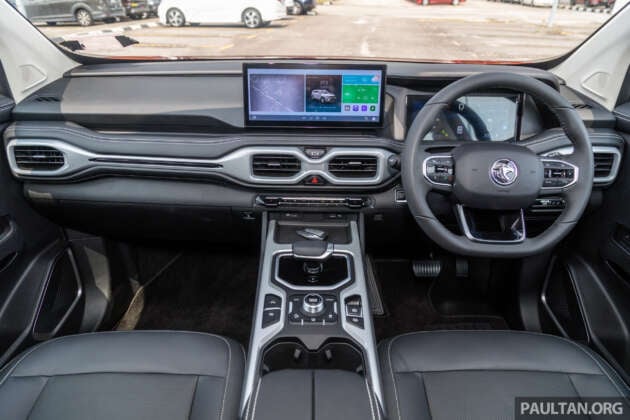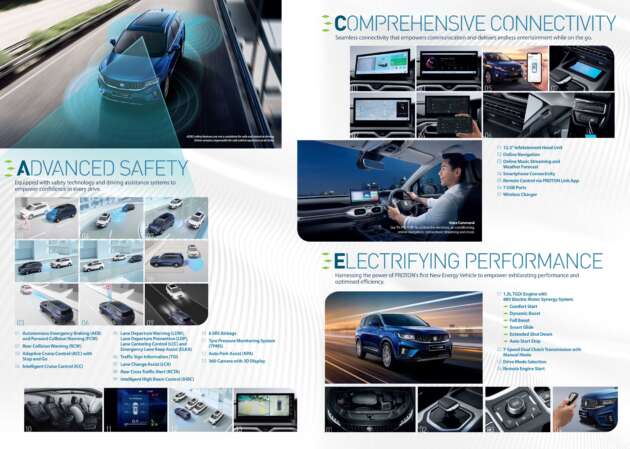
Advertisements
We’ve detailed most of the X90 in our walk-around of it at the preview, but here’s a recap of what’s on the SUV, which goes up against three-row competitors such as the Mazda CX-8, Hyundai Santa Fe and Kia Sorento.
Here’s Haoyue look with a new grille
Measuring in at 4,835 mm long, 1,900 mm wide and 1,785 mm tall, the X90 is 316 mm longer and 69 mm wider than the X70, and its 2,815 mm wheelbase makes it 145 mm longer than that of the X70.
Given that it’s a rebadged Haoyue, the exterior doesn’t veer away much from the donor model, with the only discernible changes being a new grille, one with chrome pins expanding out from the Proton logo, and fog lamp surrounds finished in black instead of chrome as found on the Geely version.
The headlights are full LED units, but unlike the adaptive LED projector example as seen on the Haoyue/Okavango, are lower-spec full LED reflector units. The design features solid-type LED daytime running lights presented in an L shape – this doubles up as the turn signal, which light up in sequential fashion.
At the back, there are no changes from the donor vehicle. Incidentally, the X90 doesn’t get the new rear as seen on the refreshed Haoyue, but the wheels are from the update. The higher end X90 variants (Premium, Flagship) ride on two-tone machine finish 19-inch units, wrapped with 235/50 Continental EcoContact 6 rubbers. Meanwhile, the Standard and Executive variants are equipped with 18-inch wheels and 225/55 profile tyres.
Going mild-hybrid, and with a different rear suspension configuration
The X90 is powered by a 1.5 litre three-cylinder turbocharged GDI engine, similar to that on the X50 Flagship as well as the newer X70 models, but with the addition of a 48V mild-hybrid system, which integrates six key components – belt-starter generator (BSG), DC-DC converter, lithium-ion battery, battery management system, recuperation braking system and the hybrid module control system – into its workings.


The inclusion of the mild-hybrid system has bumped output numbers up, with the 190 PS and 300 Nm on tap being 13 PS and 45 Nm more than the 177 PS and 255 Nm on the 1.5 TGDI without the BSG. Aside from more power and torque, the company says that mild hybrid boosted powertrain improves standing start acceleration by up to 10%, passing acceleration by up to 15% and reduces CO2 emissions by up to 13% compared to the 1.5 litre engine in the base X70.
The mill – which is made in Proton’s Tanjung Malim engine assembly plant for the X70 MC – is paired with the automaker’s familiar seven-speed wet dual-clutch transmission, with power being sent to the front wheels. You’ll note “48V EMS” badges below the wing mirrors of the car – this is the branding identifier for the X90, and the EMS stands for electric motor synergy.
As has been mentioned previously, the Haoyue has a choice of two different rear suspensions, these being a torsion beam layout and an independent multi-link setup. On the X90, Proton has opted for the multi-link configuration, which it says offers improved drivability and comfort levels. Additionally, the automaker says it has tuned the suspension for Malaysian roads.


A well-presented interior, with plenty of kit and tech
As it is with the exterior, the interior from the Haoyue has been carried over, with just the switch to a right-hand drive layout and a Proton logo on the steering wheel boss cover the only changes. A quick mention of cargo space – there’s 257 litres with the third row seats up in place, and 2,050 litres with the second and third row seats folded down.
Standard equipment for the X90 includes fabric seats, a reverse camera and dual-zone air-conditioning. The SUV also features independent rear AC, with all rows on the SUV getting air vents (roof-mounted, on the second and third rows), as well as a G-Clean system, incorporating a N95 cabin filter and ioniser.
Also to be found is a full-width 10-inch digital instrument panel (from the Executive onwards; the Standard comes with an analogue meter cluster) and a 12.3-inch infotainment touchscreen with a 1920 x 720 pixel display resolution. Running on an ACO Tech ATLAS OS, the system features a higher-spec processor and has 6 GB of RAM as well as 64 GB of internal storage. There’s still no Apple CarPlay or Android Auto support though, so users will have to rely on ATLAS’ native maps for navigation.

Advertisements
X90 Flagship interior. (From left, clockwise) X90 Standard, Executive and Premium interiors.
As for charging points for mobile devices, all three rows get them, and there are seven in all, ranging from USB Type-A and Type-C connections to wireless charging (the latter, from the Premium on). As you’d expect, the wireless charger is located in front, and aside fro a pair of Type A ports below the AC controls, there’s a USB port hidden behind the rear view mirror to power dash cams. The middle row gets a Type A and a Type C port each, while the third row gets two Type A ports.
Convenience functions include proximity auto unlock, where the vehicle will sense the keyfob approaching and unlock the doors automatically, as well as walk-away auto lock, where the system will lock the doors once you move away from the vehicle.
The Executive variant adds on front ventilated seats, with the driver’s side being a six-way power adjustable unit. The upholstery gets bumped up to leatherette, an intelligent powered tailgate, a 360-degree camera with 3D display and a tyre pressure monitoring system.
The next step up is the Premium, which adds on the aforementioned 19-inch wheels and wireless mobile charging. The ADAS active safety suite introduces three new driver assist items in the form of rear cross traffic alert, rear collision warning and traffic sign information. The variant also adds on auto park assist and Nappa leather upholstery, while the front passenger seat is now a four-way power adjustable unit.
Aside from its unique seating layout in comparison to the rest of the X90 range, the six-seater Flagship adds on a large panoramic sunroof and a front passenger ‘Boss’ switch, which allows the seat to be moved forward to provide more in the way of legroom for the second row occupant seated behind it.
The second-row captain seats, which are essentially the front seats with the addition of MPV-style adjustable armrests, are also ventilated, bringing the total of ventilated seats to four on the Flagship. The seats can be manually adjusted fore and aft, and each seat can be individually reclined.
Colours and pricing
Six colour options are available for the X90, and these are Snow White, Armour Silver, Jet Grey (available for all four variants), Cinnamon Brown, Ruby Red (both available from the Executive on) and a new shade called Marine Blue, which is available only for the Premium and Flagship.
Finally, these are the prices of the 2023 Proton X90 variants (all on-the-road, without insurance):
- Proton X90 1.5L Standard (seven-seater) – RM123,800
- Proton X90 1.5L Executive (seven-seater) – RM130,800
- Proton X90 1.5L Premium (seven-seater) – RM144,800
- Proton X90 1.5L Flagship (six-seater) – RM152,800

The automaker also announced packages and offers for the SUV at the launch. The X90 will come with a five-year unlimited mileage warranty as well as free labour for six services. There’s also a five-year data connectivity package of 1GB a month for the car as well as interest rates from as low as 2.1% and various benefits available through the Proton insurance programme.
It added that early bird packages await the first 4,000 buyers. This adds 4GB of data to the five-year connectivity package, and buyers will also receive a Proton X-Watch worth RM1,499 and a complimentary accessories package (footwell lighting, coil floor mats and a boot tray) worth RM779.
Proton X90 brochure



Advertisements
GALLERY: 2023 Proton X90 Flagship
GALLERY: 2023 Proton X90 Premium
GALLERY: 2023 Proton X90 Executive
GALLERY: 2023 Proton X90 colour variants




